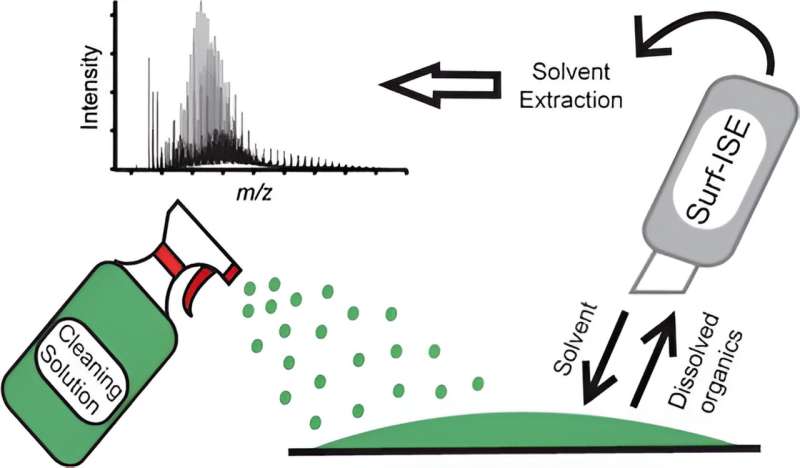This article has been reviewed according to Science X's editorial process and policies. Editors have highlighted the following attributes while ensuring the content's credibility:
fact-checked
trusted source
proofread
Cleaned surfaces may be germ-free, but they're not bare

Since the outbreak of COVID-19, surfaces in public spaces have been cleaned more often. While disinfectant solutions eliminate germs, they don't leave behind a truly bare surface. They deposit a thin film that doesn't get wiped up, even after giving the surface a good polish. Researchers reporting in ACS ES&T Air show that residues left by commercial cleaning products contain a wider range of compounds that could impact indoor air quality than previously thought.
Residues on indoor surfaces—like those deposited during cooking or cleaning—may contain compounds that are potentially harmful if absorbed through the skin or if they become airborne and are inhaled. To investigate the impact on indoor air quality, scientists study the gunk that builds up with laboratory models of surfaces.
In the models, researchers start with the assumption that a thin film exists on any "clean" surface, but the source and actual makeup of these films is unknown. Because the chemical compositions of commercial cleaning products are different from the products used to prep surfaces in the lab, Rachel O'Brien and colleagues hypothesized that commercial sanitizers could be a missing source for the films. So, they decided to characterize films left behind on recently cleaned surfaces.
Using a surface-indoor solvent extractor, the researchers directly collected films from cleaned surfaces in a controlled lab setting and on regularly washed surfaces in university buildings. This method allowed them to pick up and measure a wide array of compounds, including substances that barely evaporate.
In contrast, only semivolatile organic compounds (SVOCs) are picked up by wiping a surface film with a solvent-damp cloth, the typical method used to analyze films. The team's analyses of the residue samples by mass spectrometry found that:
- Films from commercial cleaning products were different on the model lab surfaces and university building surfaces and more complex than previously thought.
- While the composition of the films was different, they all contained SVOCs that can become airborne and impact indoor air quality.
- This method confirmed the presence of lower volatility surfactants, the primary components of soaps, in residues thought to be from the cleaning solutions. However, surfactants' effects on surface films have not yet been defined.
As a result of these findings, the researchers say that more compounds could be deposited on cleaned surfaces than had previously been identified. They add that future indoor film studies should use surfaces prepared with commercial cleaning products to identify how the residues impact indoor air quality more accurately.
Given the extent and regularity of cleaning done in public spaces and people's homes, more research is needed to determine the effects of lower volatility compounds on film growth and behavior.
More information: Rachel O'Brien et al, Contributions of Cleaning Solution Residues to Indoor Organic Surface Films, ACS ES&T Air (2024). DOI: 10.1021/acsestair.3c00053
Provided by American Chemical Society





















